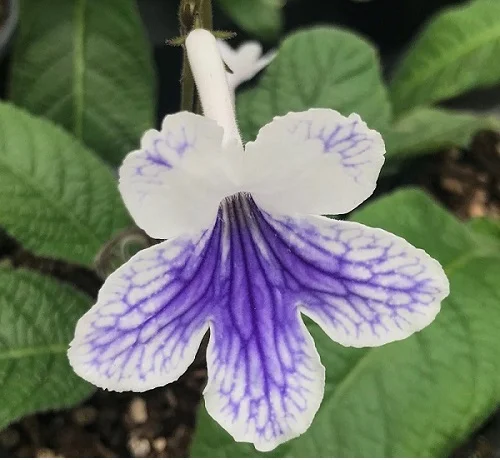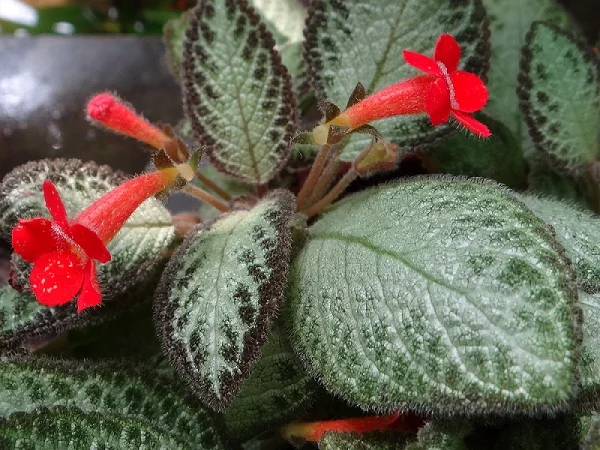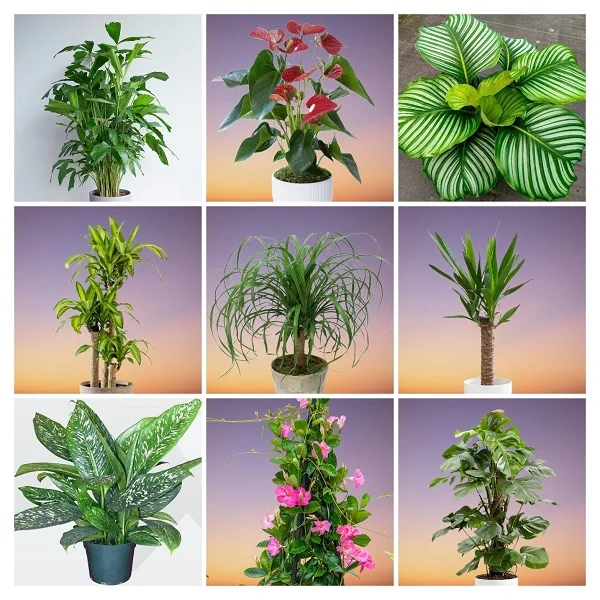Cape Primrose (Streptocarpus hybrida) Indoor Care, Propagation, Problems with Solutions
Some links in this post may be affiliate links
Cape Primrose (Streptocarpus hybrida) requires bright indirect light, warm and humid conditions and consistently moist, rich, well-drained, all purpose soil accompanied by fortnightly feeding in the growing season.
Streptocarpus hybrida is among the popular flowering plants and bears trumpet-shaped flowers in white, blue, purple, pink and red with prominently-veined throats.
The flowers in Cape Primrose hover or arch above the rosette of coarse, stemless, strap-shaped leaves which are about 8-12 inches long.
Many hybrids of various colors and forms are available but the old favorite Streptocarpus Constant Nymph which bears lilac flowers with violet veins remains the most popular. If the growing conditions are met, Cape Primrose will not bloom.
Cape Primrose requires moist air, bright light away from direct sunlight and freedom from drafts. It does not like soil that is too wet and it does not like it too hot.

Botanical name: Streptocarpus hybrida
Family: Gesneriaceae
Common name: Cape Primrose
Origin
Streptocarpus hybrida is native to South Africa where it is found growing on shaded rocky hillsides or cliffs, on the ground, in rock crevices and almost anywhere the seeds can germinate and grow.
Toxicity
According to American Society for the Prevention of Cruelty to Animals, Streptocarpus hybrida are non-toxic to humans and pets. They are safe to grow in the home.
Related Plants
Streptocarpus hybrida care is similar to that of its close relatives African Violet (Saintpaulia ionantha), Gloxinia (Sinningia speciosa) and Flame Violet (Episcia cupreata).
Where to Buy
If you are looking to add Cape Primrose to your plant collection, you may acquire them online from Etsy (Link to Etsy).
Streptocarpus hybrida Care Indoors
Cape Primrose (Streptocarpus hybrida) requires bright indirect light (dappled light), average warmth of 18-250C, humidity of 60-70% and consistently moist, rich, well-drained, all purpose soil coupled with fortnightly feeding during the growing season. Keep reading for more on these growing conditions.

Watering
Water Cape Primrose liberally during the growing season to keep the soil moist at all times while allowing the top 1-2 inches of soil to dry out between waterings.
Decrease watering during the cold season to maintain the soil slightly moist as growth is minimal at this time but do not allow the soil to dry out completely.
Ensure that the pot has a drainage hole and that the soil is free-draining to prevent it from getting soggy as it can lead to root-rot and death of the plant.
Light Requirements
Cape Primrose grows best in bright indirect light. Keep it away from direct sunlight to prevent sunscorch on the leaves. It will not bloom if the light is not enough.
Therefore, ensure it receives adequate light to promote blooming. You may instal grow lights if the natural lighting is not sufficient. Take a look at these full spectrum grow lights available on Amazon.
Regularly turn the pot to ensure the plant receives adequate light on all sides to promote even growth and prevent the plant from getting leggy.
Temperature and Humidity
Cape Primrose prefers average warmth of 18-250C. A room temperature that is comfortable for you is ideal for this plant. Keep it away from drafts to avoid sudden changes in temperature which can cause reduced growth and leaf drop.
Cape Primrose requires a humidity of 60-70% to thrive. Set the pot on a wet pebble tray or use a cool mist humidifier to raise humidity. A low humidity may result in brown leaf tips and edges. Do not mist the leaves as it can lead to fungal diseases infestation due to too wet conditions.
Occasionally clean the leaves by damp-wiping with a soft cloth to get rid of dust and also reduce pests and diseases infestations. Make sure that there is proper ventilation to discourage fungal diseases.
Fertilizer
Feed Streptocarpus hybrida with a phosphorous-rich, water-soluble fertilizer every 2-3 weeks during the growing season to promote flowering. Stop feeding in the cold season as growth is minimal and it can lead to fertilizer burn and eventual death of the plant.
Regularly flush out excess fertilizers by running a stream of water through the soil until it comes out through the drainage holes, allow to run for at least 10 minutes.
Potting Soil
The best soil for Cape Primrose should be rich in organic matter and free-draining to prevent it from getting soggy while providing the required nutrients. All purpose potting mixes are ideal for this plant.
Repotting
Repot Cape Primrose annually during the growing season as the plant is fast growing and the roots will quickly fill the pot. Use a pot that only allows 1/2 inch space around the plant as it blooms best when slightly pot-bound.
Do not repot a plant that is in flower as the repotting shock can shorten the flowering period. Make sure that the pot has a drainage hole to prevent the soil from getting soggy as it can lead to root-rot. Check out these pots with drainage holes on Amazon.
Pruning
Pruning Cape Primrose is easy. Remove dead leaves to maintain the plant neat and minimize pests and diseases infestation. After flowering, cut the flower stems at the base to encourage more blooms.
Propagation
Cape Primrose (Streptocarpus hybrida) propagation can be done at the beginning of the growing season from leaf cuttings, seeds or by plant division.
How to propagate Cape Primrose from leaf cuttings
Take leaf cuttings from a healthy Cape Primrose plant and insert the leaf petiole in moist free-draining soil.
Place the set up in a warm, well-lit spot away from direct sunlight and maintain the soil moist through out until new plants emerge at the base of the petiole.
Carefully seperate the new plants and pot them in moist free-draining soil in individual pots.
Maintain the soil moist until the new Cape Primrose plants are well established after which you can begin routine.
How to propagate Cape Primrose from seeds
Spread the Cape Primrose seeds evenly on moist free-draining soil and slightly cover with some soil.
Cover the set up with a clear plastic sheet to create a greenhouse effect and place the set up in a warm brightly-lit place.
Maintain the soil moist through out by gently misting the soil surface until germination takes place.
Transplant the seedlings when they are well established into individual pots.
Place the seedlings in a well-lit place away from direct sunlight and maintain the soil moist until new growth emerges and the Streptocarpus hybrida are well established.
How to propagate Cape Primrose by plant division
Water a large Cape Primrose thoroughly at least 1 day before to make it easier to divide and also hasten establishment. A well hydrated plant suffers less shock and takes a shorter time to take root.
Carefully divide the Cape Primrose plant into sections while ensuring each section has enough roots for faster establishment.
Pot these sections into individual pots in moist free-draining soil and ensure that each pot has a drainage hole to prevent the soil from getting soggy to avoid rotting of the plants.
Place the set up in a warm, brightly-lit place away from direct sunlight and maintain the soil moist until the new Streptocarpus hybrida are well established.

Streptocarpus hybrida Problems with Fixes
Cape Primrose (Streptocarpus hybrida) growing problems include leaf spots, brown leaf edges, lack of blooms, wilting, pests and diseases among others. Keep reading for more on these problems, their remedies and solutions.
Pests
The common pests in Cape Primrose are mealy bugs and aphids. Isolate the affected plant to prevent spread to other plants and treat it for the pests. Learn how to identify and get rid of pests in houseplants.
Diseases
The most common disease in Cape Primrose is root-rot disease which is brought about by soggy soil. Ensure that the pot has a drainage hole and the soil is free-draining to prevent it from getting soggy. Further, cut down on watering in the cold season to maintain the soil slightly moist as growth is minimal at this time. Read more on how to treat root-rot in houseplants.
Limp leaves and brown leaf edges
Limp leaves and brown leaf edges in Cape Primrose are due to soggy soil as a result of poor drainage. Maintain the soil moist but never allow the soil to become soggy.
Ensure that the pot has a drainage hole and that the soil is free-draining to prevent it from getting soggy. In addition, reduce watering during the cold season as growth is minimal at this time and therefore the plant does not require a lot of water. Learn more on how to water indoor plants the right way.
Lack of blooms
Cape Primrose will not bloom if the light is too little. Move the plant to a brighter spot where it will receive bright indirect light or consider investing in grow lights if the natural lighting is not adequate. Check out this post on understanding light for houseplants.
Brown leaf spots
Brown leaf spots in Cape Primrose are sunscorch marks which are caused by exposure of the plant to direct sunlight. Keep the plant away from direct sunlight or shield it from direct sunlight.
Dull and wilted leaves
Dull and wilted leaves in Cape Primrose are due to underwatering. Maintain the soil consistently moist and allow the top 1-2 inches of soil to dry out between waterings. Never allow the soil ball to dry out completely.
You liked it? Share on social media.
Related Content
Amazon Associates Disclosure
Homeplantsguide.com is a participant in the Amazon Services LLC Associates Program, an affiliate advertising program designed to provide a means for sites to earn advertising fees by advertising and linking to amazon.com.





